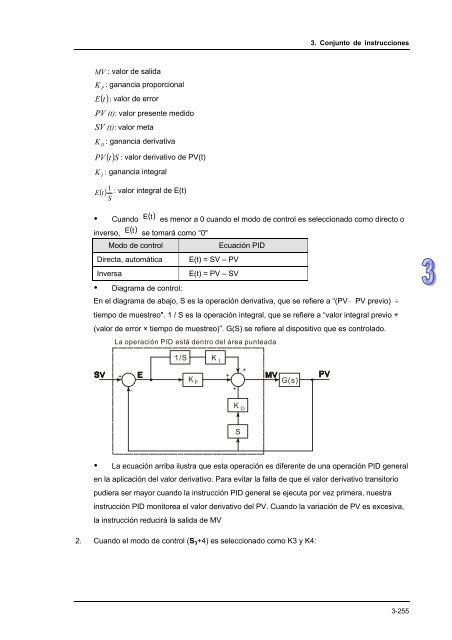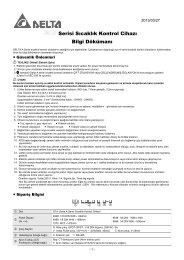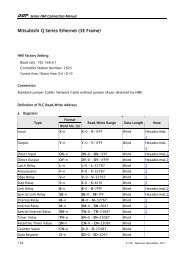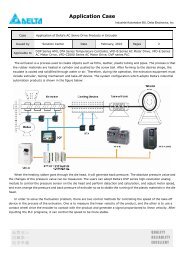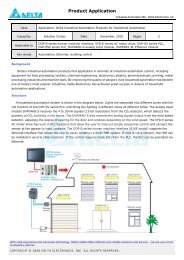- Page 2 and 3:
Conceptos de PLC Este capítulo int
- Page 4 and 5:
Calcular el tiempo de exploración.
- Page 6 and 7:
1.5 Símbolos de Lógica de Escaler
- Page 8 and 9:
El orden de ejecución del programa
- Page 10 and 11:
Instrucción de bifurcación Símbo
- Page 12 and 13:
1.6 Conversión entre diagrama de e
- Page 14 and 15:
Corriente inversa 1. Conceptos de P
- Page 16 and 17:
Ejemplo 3: La “corriente inversa
- Page 18 and 19:
Ejemplo 2 - Circuito enclavado Para
- Page 20 and 21:
1. Conceptos de PLC Ejemplo 10 - Ci
- Page 22 and 23:
Diagrama de temporización: Luz ver
- Page 24 and 25:
Programación WPLSoft (modo SFC) L
- Page 26 and 27:
Conceptos de programación DVP-ES2/
- Page 28 and 29:
Registro de palabra S Punto escalon
- Page 30 and 31:
2.2 Mapa de memoria SS2 Método de
- Page 32 and 33:
Constante Puertos seriales K Decima
- Page 34 and 35:
Registro de palabra S Punto escalon
- Page 36 and 37:
2.4 Mapa de memoria SX2 Método de
- Page 38 and 39:
Indicador Constante Puertos seriale
- Page 40 and 41:
2.5 Estado y asignación de memoria
- Page 42 and 43:
Constante K: 2. Conceptos de progra
- Page 44 and 45:
M especial Función ES2 EX2 SS2 SA2
- Page 46 and 47:
M especial M1085 M1086 M1088 M1089
- Page 48 and 49:
M especial M1138* M1139* M1140 M114
- Page 50 and 51:
M especial M1233 M1234 M1235 M1236
- Page 52 and 53:
M especial M1353* M1354* M1355* M13
- Page 54 and 55:
M especial Función ES2 EX2 SS2 SA2
- Page 56 and 57:
2.9 Relé S 2. Conceptos de program
- Page 58 and 59:
contadores de16 bits contadores de3
- Page 60 and 61:
2. Conceptos de programación Los r
- Page 62 and 63:
Contadores de Alta Velocidad de Sop
- Page 64 and 65:
Contador de alta velocidad de 1 fas
- Page 66 and 67:
2. Conceptos de programación 4. El
- Page 68 and 69:
D especial Contenido D1045 No. del
- Page 70 and 71:
D especial D1129 D1130 D1131 D1132
- Page 72 and 73:
D especial D1245 D1249 D1250 D1252
- Page 74 and 75:
D especial D1365* D1366* D1367* D13
- Page 76 and 77:
D especial D1452* D1453* D1454* D14
- Page 78 and 79:
D especial D1704* ↓ D1719* D1720*
- Page 80 and 81:
D especial D1996 D1997 D1998 D1999
- Page 82 and 83:
Indicador I Para interrupción Inte
- Page 84 and 85:
específicos se establecen a byte b
- Page 86 and 87:
2. Conceptos de programación 2. El
- Page 88 and 89:
2. Conceptos de programación 2. El
- Page 90 and 91:
Contenido: 2. Conceptos de programa
- Page 92 and 93:
Grupo de función Estado de salida
- Page 94 and 95:
M1002 MOV H86 D1036 SET M1138 Ejemp
- Page 96 and 97:
Contenido: 2. Conceptos de programa
- Page 98 and 99:
Grupo de función Detección de mó
- Page 100 and 101:
2. Conceptos de programación Grupo
- Page 102 and 103:
2. Conceptos de programación M1368
- Page 104 and 105:
PLC Esclavo* 2. Conceptos de progra
- Page 106 and 107:
2. Conceptos de programación múlt
- Page 108 and 109:
10. Diagrama de flujo de operación
- Page 110 and 111:
PLC Maestro Valor preestablecido PL
- Page 112 and 113:
Conjunto de instrucciones Este cap
- Page 114 and 115:
3.2 Explicaciones de instrucciones
- Page 116 and 117:
Mnemónico Operandos Función ORI X
- Page 118 and 119:
Puntos a tomar en cuenta: 1. Ningú
- Page 120 and 121:
Ejemplo de programa: Diagrama de es
- Page 122 and 123:
Ejemplo de programa: Diagrama de es
- Page 124 and 125:
3.5 Instrucciones de programación
- Page 126 and 127:
Número API para la instrucción El
- Page 128 and 129:
Valores Kn 3. Conjunto de instrucci
- Page 130 and 131:
3. Conjunto de instrucciones 6. Par
- Page 132 and 133:
3. Conjunto de instrucciones el pun
- Page 134 and 135:
excede el rango de uso. Registros
- Page 136 and 137:
Cuatro operaciones aritméticas API
- Page 138 and 139:
API 3. Conjunto de instrucciones Mn
- Page 140 and 141:
API 3. Conjunto de instrucciones Mn
- Page 142 and 143:
API 3. Conjunto de instrucciones Mn
- Page 144 and 145:
Comparación tipo contacto API 3. C
- Page 146 and 147:
3.7 Explicación detallada de instr
- Page 148 and 149:
M7, M10 OFF C0~C234 *3 M7 OFF, M10
- Page 150 and 151:
API Mnemónico Operandos Función 0
- Page 152 and 153:
3. Conjunto de instrucciones Ejempl
- Page 154 and 155:
API Mnemónico Función 04 EI Habil
- Page 156 and 157:
M1284 M1286 I400/I401 Dirección in
- Page 158 and 159:
API Mnemónico Función 06 FEND El
- Page 160 and 161:
Flujo de programa de la instrucció
- Page 162 and 163:
3. Conjunto de instrucciones Ejempl
- Page 164 and 165:
Ejemplo de programa 1: 3. Conjunto
- Page 166 and 167:
API Mnemónico Operandos Función 1
- Page 168 and 169:
3. Use la instrucción RST o ZRST p
- Page 170 and 171:
API Mnemónico Operandos Función 1
- Page 172 and 173:
3. Conjunto de instrucciones Ejempl
- Page 174 and 175:
Ejemplo de programa 2: El diagrama
- Page 176 and 177:
3. Conjunto de instrucciones Ejempl
- Page 178 and 179:
API Mnemónico Operandos Función 1
- Page 180 and 181:
API Mnemónico Operandos Función 1
- Page 182 and 183:
X0 8 BIN K4X20 D100 BCD D100 K4Y20
- Page 184 and 185:
Operación de banderas: 3. Conjunto
- Page 186 and 187:
API Mnemónico Operandos Función 2
- Page 188 and 189:
API Mnemónico Operandos Función 2
- Page 190 and 191:
API Mnemónico Operandos Función 2
- Page 192 and 193:
API Mnemónico Operandos Función 2
- Page 194 and 195:
API Mnemónico Operandos Función 2
- Page 196 and 197:
API Mnemónico Operandos Función 2
- Page 198 and 199:
API Mnemónico Operandos Función 2
- Page 200 and 201:
(D0=2) 0 0 0 0 0 0 0 0 0 0 0 0 0 0
- Page 202 and 203:
API Mnemónico Operandos Función 3
- Page 204 and 205:
API Mnemónico Operandos Función 3
- Page 206 and 207:
5 X0 X3 X2 X1 X0 SFTR X0 M0 K16 K4
- Page 208 and 209:
API Mnemónico Operandos Función 3
- Page 210 and 211:
API Mnemónico Operandos Función 3
- Page 212 and 213:
X20 X0 D20 RST D0 SFWRP D20 D0 K10
- Page 214 and 215:
API Mnemónico Operandos Función 4
- Page 216 and 217:
API Mnemónico Operandos Función 4
- Page 218 and 219:
API Mnemónico Operandos Función 4
- Page 220 and 221:
API Mnemónico Operandos Función 4
- Page 222 and 223:
API Mnemónico Operandos Función 4
- Page 224 and 225:
API Mnemónico Función 47 ANR P Re
- Page 226 and 227:
API Mnemónico Operandos Función 4
- Page 228 and 229:
M1002 X20 X21 RST M1081 FLT D0 D12
- Page 230 and 231:
API Mnemónico Operandos Función 5
- Page 232 and 233:
API Mnemónico Operandos Función 5
- Page 234 and 235:
API Mnemónico Operandos Función 5
- Page 236 and 237:
3. Conjunto de instrucciones Puntos
- Page 238 and 239:
3. Conjunto de instrucciones Cuand
- Page 240 and 241:
3. Conjunto de instrucciones 7. Dif
- Page 242 and 243:
3. Conjunto de instrucciones luego
- Page 244 and 245:
3. Conjunto de instrucciones API 55
- Page 246 and 247:
3. Conjunto de instrucciones Los d
- Page 248 and 249:
API Mnemónico Operandos Función 5
- Page 250 and 251:
3. Conjunto de instrucciones Ejempl
- Page 252 and 253:
5. Cuatro modos de salida de pulso:
- Page 254 and 255:
3. Conjunto de instrucciones M1524:
- Page 256 and 257:
API Mnemónic o 58 PWM Operandos Fu
- Page 258 and 259:
API Mnemónico Operandos Función 5
- Page 260 and 261:
3. Conjunto de instrucciones a) Cua
- Page 262 and 263:
3. Conjunto de instrucciones M1158
- Page 264 and 265:
4. Operación de función de másca
- Page 266 and 267:
API Mnemónic o Operandos Función
- Page 268 and 269:
3. Conjunto de instrucciones 4. Mod
- Page 270 and 271:
3. Conjunto de instrucciones 9. Ope
- Page 272 and 273:
Explicación de bandera: 3. Conjunt
- Page 274 and 275:
API Mnemónico Operandos Función 6
- Page 276 and 277:
API Mnemónic o 62 D ABSD Operandos
- Page 278 and 279:
API Mnemónic o 63 INCD Operandos F
- Page 280 and 281:
API Mnemónico Operandos Función 6
- Page 282 and 283:
API Mnemónico Operandos Función 6
- Page 284 and 285:
API Mnemónico Operandos Función 6
- Page 286 and 287:
3. Conjunto de instrucciones 4. Est
- Page 288 and 289:
Byte Hi-byte alto Byte Lo-byte bajo
- Page 290 and 291:
S+0 S+1 S+2 S+3 S+4 S+5 S+6 S+7 S+8
- Page 292 and 293:
3. Conjunto de instrucciones 3-181
- Page 294 and 295:
Ejemplo de tabla de clasificación
- Page 296 and 297:
desbordamiento 0 1 2 3 4 5 6 7 8 9
- Page 298 and 299:
2. Teclas de entrada 0~9: desbordam
- Page 300 and 301:
API Mnemónic o Operandos Función
- Page 302 and 303:
API Mnemónico Operandos Función 7
- Page 304 and 305:
3. Conjunto de instrucciones 2. Cua
- Page 306 and 307:
Valor BCD Salida Y (código BCD) Sa
- Page 308 and 309:
3. Conjunto de instrucciones 3. Al
- Page 310 and 311:
API Mnemónico Operandos Función 7
- Page 312 and 313:
API Mnemónico Operandos Función 7
- Page 314 and 315:
3. Conjunto de instrucciones 3. La
- Page 316 and 317: 3. Conjunto de instrucciones Ejempl
- Page 318 and 319: Envío de datos: (PLC -> equipo ext
- Page 320 and 321: Registro Datos Explicación D127 al
- Page 322 and 323: 3. Conjunto de instrucciones Ejempl
- Page 324 and 325: M1002 Pulse para solicitud de enví
- Page 326 and 327: 3. Conjunto de instrucciones Bander
- Page 328 and 329: 3. Conjunto de instrucciones Bander
- Page 330 and 331: Registro especial D1126 D1129 D1130
- Page 332 and 333: Registro especial D1038 D1109 D1169
- Page 334 and 335: Errores 3. Conjunto de instruccione
- Page 336 and 337: M1002 MOV H788 D1120 3. Conjunto de
- Page 338 and 339: Modo RTU Código de función Direcc
- Page 340 and 341: Dirección de 21 H datos de inicio
- Page 342 and 343: API Mnemónico Operandos Función 8
- Page 344 and 345: API Mnemónico Operandos Función 8
- Page 346 and 347: D25 byte alto D26 byte bajo D26 byt
- Page 348 and 349: 6. Cuando n = 1 ~ 16: D n 3. Conjun
- Page 350 and 351: API Mnemónico Operandos Función 8
- Page 352 and 353: 2. Asumir: S código ASCII conversi
- Page 354 and 355: API Mnemónico Operandos Función 8
- Page 356 and 357: API Mnemónico Operandos Función 8
- Page 358 and 359: API Mnemónico Operandos Función 8
- Page 360 and 361: 3. Conjunto de instrucciones 3. Dia
- Page 362 and 363: Disposit ivo No. S3+6: S3+7: S3+8:
- Page 364 and 365: Dispositivo No. S3+3: Función Gana
- Page 368 and 369: () t SV() t - PV() t E = Diagrama
- Page 370 and 371: 1.5 1 0.5 K =40 P K =20 P K =10 P K
- Page 372 and 373: Ejemplo de programa de función de
- Page 374 and 375: 3. Conjunto de instrucciones Propie
- Page 376 and 377: 3. Conjunto de instrucciones Del re
- Page 378 and 379: API Mnemónico Operandos Función 9
- Page 380 and 381: API Mnemónico Operandos Función 9
- Page 382 and 383: API Mnemónico Operandos Función 9
- Page 384 and 385: API Mnemónico Operandos Función 9
- Page 386 and 387: API Mnemónico Operandos Función 9
- Page 388 and 389: API Mnemónico Operandos Función 9
- Page 390 and 391: 3. Conjunto de instrucciones Ejempl
- Page 392 and 393: 3. Conjunto de instrucciones Ejempl
- Page 394 and 395: M1002 X0 M1129 M1140 M1141 X0 MOV H
- Page 396 and 397: 3. Conjunto de instrucciones Ejempl
- Page 398 and 399: Registros para datos a enviar (mens
- Page 400 and 401: API Mnemónico Operandos Función 1
- Page 402 and 403: 3. Conjunto de instrucciones Ejempl
- Page 404 and 405: 3. Conjunto de instrucciones Ejempl
- Page 406 and 407: API Mnemónic o Operandos Función
- Page 408 and 409: 3. Conjunto de instrucciones “CD
- Page 410 and 411: ‘3’ 33 H ‘E’ 45 H ‘0’ 3
- Page 412 and 413: 3. Conjunto de instrucciones Ejempl
- Page 414 and 415: API Mnemónico Operandos Función 1
- Page 416 and 417:
3. Conjunto de instrucciones Verifi
- Page 418 and 419:
3. Conjunto de instrucciones Ejempl
- Page 420 and 421:
API Mnemónico Operandos Función 1
- Page 422 and 423:
API Mnemónico Operandos Función 1
- Page 424 and 425:
API Mnemónico Operandos Función 1
- Page 426 and 427:
3. Conjunto de instrucciones 2. Cua
- Page 428 and 429:
API Mnemónico Operandos Función 1
- Page 430 and 431:
API Mnemónico Operandos Función 1
- Page 432 and 433:
API Mnemónico Operandos Función 1
- Page 434 and 435:
3. Conjunto de instrucciones 3. Cua
- Page 436 and 437:
API Mnemónico Operandos Función 1
- Page 438 and 439:
API Mnemónico Operandos Función 1
- Page 440 and 441:
3. Conjunto de instrucciones Ejempl
- Page 442 and 443:
3. Conjunto de instrucciones Ejempl
- Page 444 and 445:
S D D1 D0 D11 D10 Punto flotante bi
- Page 446 and 447:
3. Conjunto de instrucciones Ejempl
- Page 448 and 449:
3. Conjunto de instrucciones Ejempl
- Page 450 and 451:
API Mnemónico Operandos Función 1
- Page 452 and 453:
3. Conjunto de instrucciones Puntos
- Page 454 and 455:
API Mnemónico Operandos Función 1
- Page 456 and 457:
3. Conjunto de instrucciones 11. Pa
- Page 458 and 459:
3. Conjunto de instrucciones Modo R
- Page 460 and 461:
Registro receptor de datos D0 de PL
- Page 462 and 463:
M1002 X0 X0 MOV H87 SET M1120 D1120
- Page 464 and 465:
D11 byte bajo ‘0’ 30 H D11 byte
- Page 466 and 467:
5. M1316→M1312: solicitud de env
- Page 468 and 469:
M1002 X0 X0 MOV H87 SET M1120 D1120
- Page 470 and 471:
Registro Datos Descripciones D1072
- Page 472 and 473:
3. Conjunto de instrucciones 4. Tom
- Page 474 and 475:
D1262 byte bajo 8C H CRC CHK baja D
- Page 476 and 477:
3. Conjunto de instrucciones 4. Tom
- Page 478 and 479:
Registros para datos a enviar (mens
- Page 480 and 481:
3. Conjunto de instrucciones Ejempl
- Page 482 and 483:
Registro Datos Descripciones D1074
- Page 484 and 485:
3. Conjunto de instrucciones Modo
- Page 486 and 487:
API Mnemónico Operandos Función 1
- Page 488 and 489:
Puntos a tomar en cuenta: 3. Diagra
- Page 490 and 491:
3. Conjunto de instrucciones 7. Cua
- Page 492 and 493:
API Mnemónico Operandos Función 1
- Page 494 and 495:
3. Conjunto de instrucciones 10. M1
- Page 496 and 497:
3. Conjunto de instrucciones M1524
- Page 498 and 499:
3. Conjunto de instrucciones 9. D13
- Page 500 and 501:
API Mnemónico Operandos Función 1
- Page 502 and 503:
3. Conjunto de instrucciones Ejempl
- Page 504 and 505:
API Mnemónico Operandos Función 1
- Page 506 and 507:
API Mnemónico Operandos Función 1
- Page 508 and 509:
Dispositivo Contenido Rango D1313 S
- Page 510 and 511:
3. Conjunto de instrucciones Ejempl
- Page 512 and 513:
Ejemplo de programa 2: Simplifique
- Page 514 and 515:
3. Conjunto de instrucciones Ejempl
- Page 516 and 517:
API Mnemónico Operandos Función 1
- Page 518 and 519:
3. Conjunto de instrucciones Ejempl
- Page 520 and 521:
3. Conjunto de instrucciones Ejempl
- Page 522 and 523:
3. Conjunto de instrucciones Ejempl
- Page 524 and 525:
3. Conjunto de instrucciones Ejempl
- Page 526 and 527:
API Mnemónico Operandos Función 1
- Page 528 and 529:
3. Conjunto de instrucciones 7. Si
- Page 530 and 531:
API Mnemónico Operandos Función 1
- Page 532 and 533:
3. Conjunto de instrucciones Ejempl
- Page 534 and 535:
API Mnemónico Operandos Función 1
- Page 536 and 537:
API Mnemónico Operandos Función 1
- Page 538 and 539:
API Mnemónico Operandos Función 1
- Page 540 and 541:
API Mnemónico Operandos Función 1
- Page 542 and 543:
API Mnemónico Operandos Función 1
- Page 544 and 545:
API Mnemónico Operandos Función 1
- Page 546 and 547:
API Mnemónico Operandos Función 1
- Page 548 and 549:
API Mnemónico Operandos Función 1
- Page 550 and 551:
API Mnemónico Operandos Función 1
- Page 552 and 553:
3. Conjunto de instrucciones 7. Cua
- Page 554 and 555:
API Mnemónico Operandos Función 1
- Page 556 and 557:
API Mnemónico Operandos Función 1
- Page 558 and 559:
3. Conjunto de instrucciones 9. D p
- Page 560 and 561:
3. Conjunto de instrucciones 2. Pas
- Page 562 and 563:
3. Conjunto de instrucciones 2. Pas
- Page 564 and 565:
3. Conjunto de instrucciones 3. Ope
- Page 566 and 567:
2. Formato de la tabla: S2 = D300,
- Page 568 and 569:
API Mnemónico Operandos Función 1
- Page 570 and 571:
3. Conjunto de instrucciones Explic
- Page 572 and 573:
2. Resultados de ejecución: Frecue
- Page 574 and 575:
3. Conjunto de instrucciones 3. Obs
- Page 576 and 577:
D1245: 3. Conjunto de instrucciones
- Page 578 and 579:
Explicaciones de función: Diagrama
- Page 580 and 581:
M1538 Indicador de estado de pausa
- Page 582 and 583:
3. Conjunto de instrucciones Explic
- Page 584 and 585:
I601 I701 M0 M1000 M1000 EI DMOVP K
- Page 586 and 587:
3. Conjunto de instrucciones Ejempl
- Page 588 and 589:
3. Conjunto de instrucciones API 20
- Page 590 and 591:
3. Conjunto de instrucciones 2. Ecu
- Page 592 and 593:
3. Conjunto de instrucciones Puntos
- Page 594 and 595:
3. Conjunto de instrucciones Despu
- Page 596:
K5(H5) Comando de velocidad (3 conj
- Page 599 and 600:
Manual de operación de DVP-ES2/SX2
- Page 601 and 602:
Manual de operación de DVP-ES2/SX2
- Page 603 and 604:
Manual de operación de DVP-ES2/SX2
- Page 605 and 606:
Manual de operación de DVP-ES2/SX2
- Page 607 and 608:
Manual de operación de DVP-ES2/SX2
- Page 609 and 610:
Manual de operación de DVP-ES2/SX2
- Page 611 and 612:
Manual de operación de DVP-ES2/SX2
- Page 613 and 614:
Manual de operación de DVP-ES2/SX2
- Page 615 and 616:
Manual de operación de DVP-ES2/SX2
- Page 617 and 618:
Manual de operación de DVP-ES2/SX2
- Page 619 and 620:
Comunicaciones Este capítulo prese
- Page 621 and 622:
Configuración de comunicación pre
- Page 623 and 624:
PLC→PC “: 01 03 10 00 01 00 02
- Page 625 and 626:
Mensaje de retroalimentación: Nomb
- Page 627 and 628:
PLC→PC “ 01 03 10 00 01 00 02 0
- Page 629 and 630:
4. Comunicaciones 2. El PLC recibe
- Page 631 and 632:
4. Comunicaciones Dispositivo Rango
- Page 633 and 634:
4. Comunicaciones 4.5.2 Código de
- Page 635 and 636:
Nombre de campo ASCII Datos baja (T
- Page 637 and 638:
Nombre de campo ASCII Código de co
- Page 639 and 640:
MEMO 4. Comunicaciones 4-21
- Page 641 and 642:
Manual de Operación de DVP-ES2EX2/
- Page 643 and 644:
Manual de Operación de DVP-ES2EX2/
- Page 645 and 646:
Manual de Operación de DVP-ES2EX2/
- Page 647 and 648:
Manual de Operación de DVP-ES2EX2/
- Page 649 and 650:
Manual de Operación de DVP-ES2EX2/
- Page 651 and 652:
Manual de Operación de DVP-ES2EX2/
- Page 653 and 654:
Manual de Operación de DVP-ES2EX2/
- Page 655 and 656:
Manual de Operación de DVP-ES2EX2/
- Page 657 and 658:
Manual de Operación de DVP-ES2EX2/
- Page 659 and 660:
Manual de Operación de DVP-ES2EX2/
- Page 661 and 662:
Manual de Operación de DVP-ES2EX2/
- Page 663 and 664:
Manual de Operación de DVP-ES2EX2/
- Page 665 and 666:
Manual de Operación de DVP-ES2EX2/
- Page 667 and 668:
Manual de Operación de DVP-ES2EX2/
- Page 669 and 670:
Manual de Operación de DVP-ES2EX2/
- Page 671 and 672:
Localización de fallas Este capít
- Page 673 and 674:
Síntoma Localización de fallas y
- Page 675 and 676:
Síntoma Localización de fallas y
- Page 677 and 678:
0E18 Error de conversión de BCD 0E
- Page 679 and 680:
6.3 Dispositivos de detección de e


